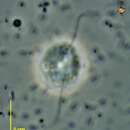Description of Cercomonadida
provided by BioPedia
Circumscription: Biflagellated gliding protists, anterior flagellum beating stiffly, posterior flagellum trailing, body more or less capable of producing pseudopodia, may be amoeboid. Argued by some to be related to Chlorarachnion but both probably belong to a more extensive group (including cercomonads, Chlorarachnion, some slime moulds, thaumatomonads, Hyperamoeba) of tubulocristate flagellates with. a tendency to an amoeboid body form, but which has yet to be properly defined. Common and widespread. Ultrastructural identity: With tubular cristae in mitochondria. Dictyosomes. Two flagella without excrescences or paraxonemal structures; basal bodies inserting almost at right angles, interconnected with non-microtubular material and giving rise to several microtubular roots (Massisteria excepted). With darkly staining membrane-bound paranuclear body. With electron-dense or concentric extrusomes. Nuclear envelope breaks down during mitosis, spindle microtubules arise at basal bodies. Synapomorphy: Tubulocristate protists with paranuclear body.

